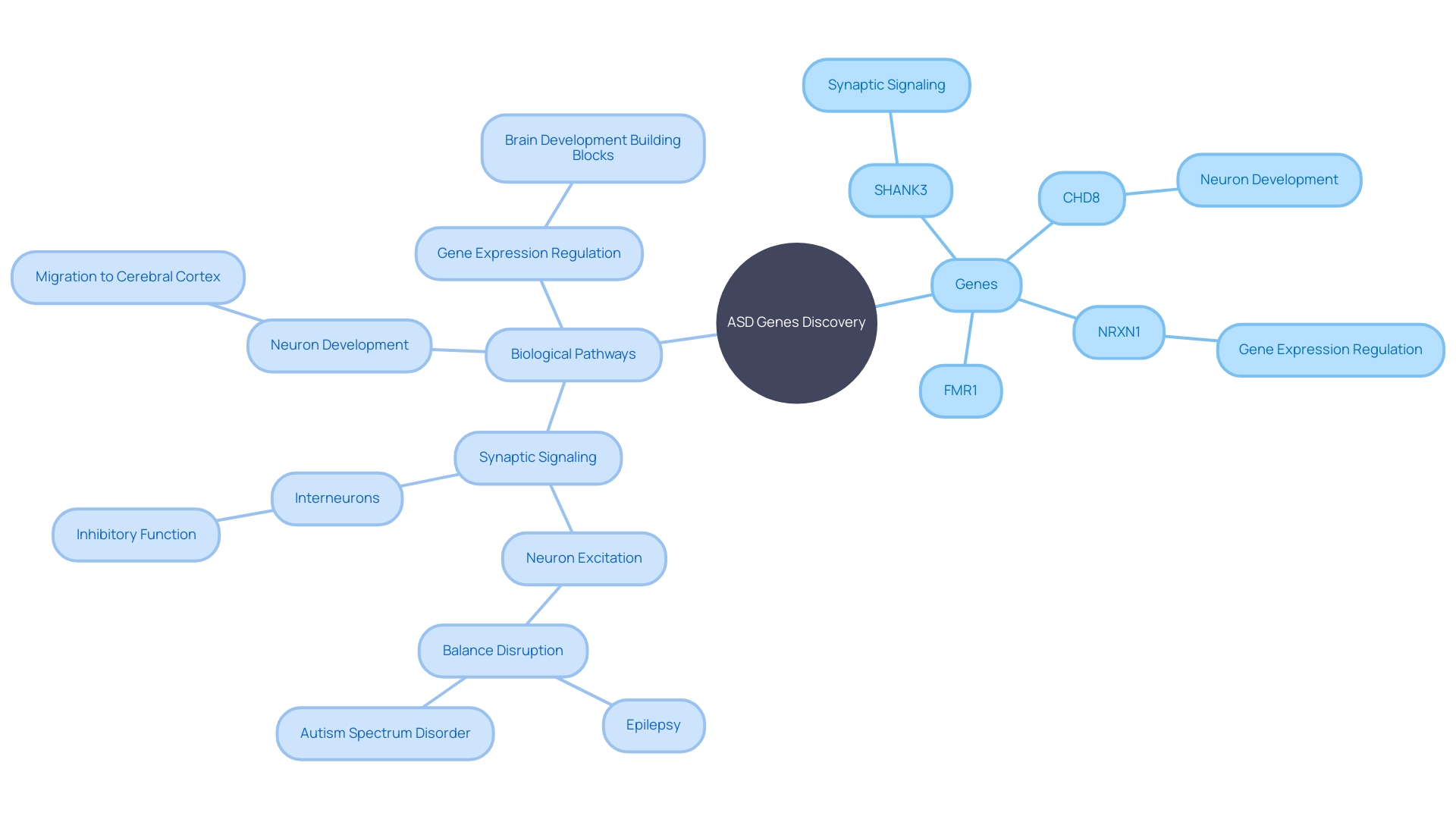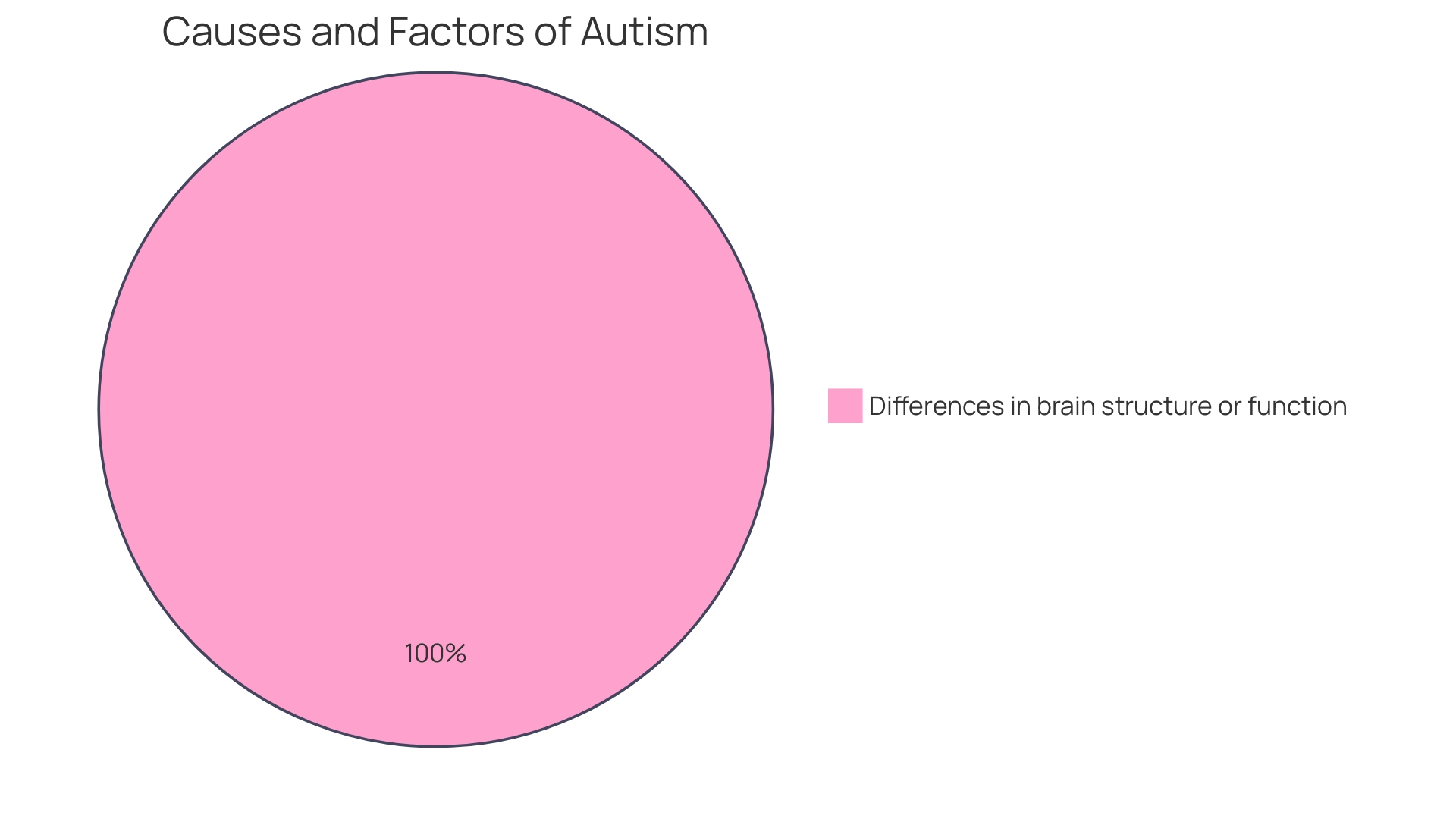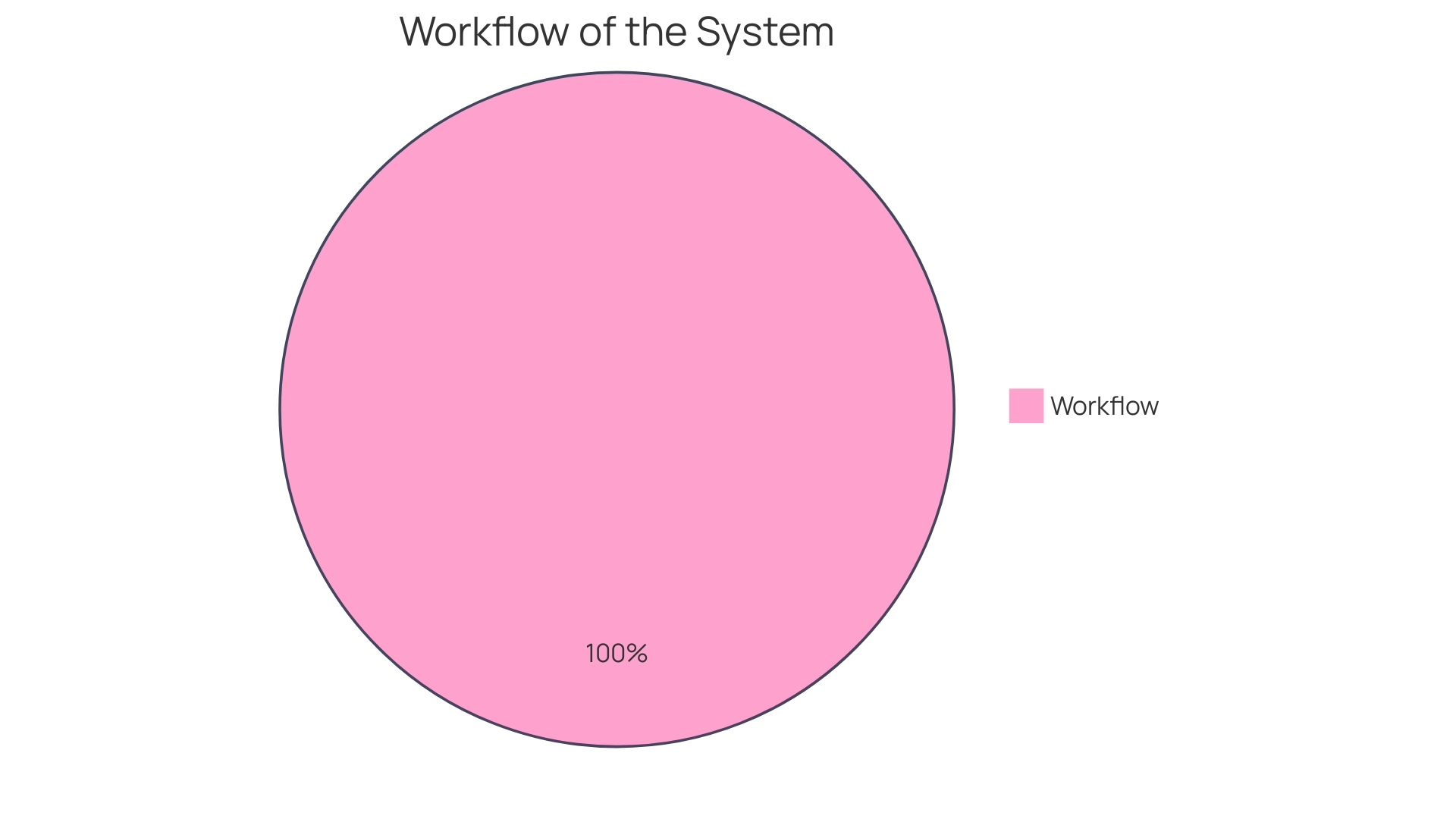Introduction
Autism Spectrum Disorder (ASD) is a complex condition influenced by a network of genetic factors. Groundbreaking research has provided valuable insights into the genetic intricacies of ASD, shedding light on its development and manifestation. The interdisciplinary efforts of researchers like Professor Iossifov from Cold Spring Harbor Laboratory (CSHL) have paved the way for innovative tools such as Genotypes and Phenotypes in Families (GPF), which uncover layers of ASD's genetic roots.
It's important to note that while genetics play a significant role, ASD's spectrum is broad, encompassing a range of abilities and challenges. However, the genetic commonalities offer hope for tailored interventions. Researchers, supported by organizations like the National Institutes of Health, are dedicated to improving lives and fostering supportive environments for all affected by ASD.
As our understanding of ASD's genetic landscape expands, so too does our capacity to empower parents and advocates in navigating the challenges and ensuring the well-being of their children.
The Role of Genetics in Autism Spectrum Disorder
Autism Spectrum Disorder (ASD) presents a tapestry of challenges and strengths, influenced heavily by a network of genetic factors. Groundbreaking research, like that of Professor Iossifov from Cold Spring Harbor Laboratory (CSHL), shines a light on the genetic intricacies of ASD. His journey from computer science to the forefront of autism genetics underscores the interdisciplinary effort required to decode the condition.
Iossifov's Genotypes and Phenotypes in Families (GPF) tool is a testament to this, poised to uncover layers of ASD's genetic roots.
The scientific community upholds rigorous ethical standards in this quest, as evidenced by the strict adherence to guidelines and approvals from bodies like the Danish Data Protection Agency. It's important to note that while genetics provide a significant piece of the puzzle, ASD's spectrum is broad, encompassing a range of abilities and challenges. From those who navigate daily life independently to others who require substantial support, the genetic commonalities offer a beacon for tailored interventions.
With a focus on improving lives, researchers like those at CSHL, supported by the National Institutes of Health, persist in their ethical, patient-focused studies. Their dedication ensures that as our understanding of ASD's genetic landscape expands, so too does our capacity to foster supportive environments for all affected by the disorder.
Heritability of Autism Spectrum Disorder: Twin and Family Studies
Groundbreaking research has significantly advanced our understanding of the genetic factors involved in Autism Spectrum Disorder (ASD). Twin studies, a cornerstone of genetic research, have revealed compelling evidence of the genetic underpinnings of ASD. Identical twins, who share all their genes, have a considerably higher rate of both being affected by ASD compared to fraternal twins, who share about half of their genes.
This disparity in concordance rates underscores the influence of genetics in the development of ASD.
Adding to this genetic perspective, family studies have illuminated the familial risk associated with ASD. Siblings and close relatives of individuals with ASD are at an increased risk of developing the disorder themselves, hinting at the hereditary components at play.
In the realm of genetic research, the work conducted by Professor Iossifov has been particularly illuminating. Transitioning from a computer science background to the field of computational biology, Iossifov has contributed to the development of innovative tools like Genotypes and Phenotypes in Families (GPF). This tool holds the potential to uncover novel insights into the genetic basis of ASD.
His journey from a fascination with computers to pioneering genetic research illustrates the interdisciplinary nature of modern science in unraveling complex conditions like ASD.
These findings, while significant, are part of a larger, ongoing conversation in the scientific community. The research mentioned adheres to strict ethical guidelines, and the studies are approved by relevant oversight bodies, ensuring that the pursuit of knowledge is conducted responsibly. It is important to recognize that while this information provides valuable insights, it should not be used as a substitute for professional medical advice.
Identified Genetic Factors and Associated Genes
Meticulous research efforts have led to the discovery of certain genes that are instrumental in Autism Spectrum Disorder (ASD), offering a deeper understanding of its genetic underpinnings. Genes such as SHANK3, CHD8, NRXN1, and FMR1 have been spotlighted for their roles in critical biological pathways including synaptic signaling, neuron development, and gene expression regulation. These findings are a testament to the dedication of researchers who adhere to ethical guidelines and rigorous scientific standards in their studies, as evidenced by approvals from bodies like the Danish Data Protection Agency and compliance with regulations for clinical trials registration.
The National Institute of Mental Health (NIMH) has curated a list of genes with considerable statistical backing for their association with mental health conditions, which serves as a valuable resource for researchers focusing on rare genetic variations linked to psychiatric illnesses. This evolving genetic landscape not only enhances our comprehension of ASD but also paves the way for tailored interventions that address these specific genetic factors.

Genetic Mutations and Copy Number Variations
Autism Spectrum Disorder (ASD) is not solely identified through behavioral characteristics; its roots delve deep into the genetic blueprint of individuals. With up to 90% heritability, genetics play a pivotal role in the development and manifestation of ASD symptoms. Intricate genetic alterations, such as mutations in key genes or variations in the number of gene copies, known as copy number variations (CNVs), are significant contributors to these developmental differences.
Notably, CNVs can substantially increase the relative risk of autism, with over 200 variations linked to the condition.
These genetic disruptions, whether spontaneous de novo mutations or inherited, can interfere with normal brain development and function. For instance, an imbalance between inhibitory and excitatory neurons in the cerebral cortex could underpin ASD and even epilepsy. This underscores the complexity of the disorder, reflecting a spectrum where some individuals may face profound daily challenges, while others might exhibit minimal to no communication or self-sufficiency difficulties.
Despite the complexity, advancements in genetic research, like the Genotypes and Phenotypes in Families (GPF) tool, are paving the way for groundbreaking discoveries. Moreover, innovative techniques such as transport-based morphometry are revealing brain structure patterns linked to genetic variations. These approaches not only enhance our understanding of autism's origins but also hold the promise of developing more targeted treatments.
Yet, less than half of individuals with autism currently undergo genetic testing. Embracing a genetics-first methodology could revolutionize patient subtyping, providing a clearer understanding of ASD's roots and leading to interventions that are finely tuned to the genetic underpinnings of this diverse and multifaceted condition.
Gene-Environment Interactions in Autism Spectrum Disorder
Autism Spectrum Disorder (ASD) is a complex condition, often manifesting in early childhood, characterized by unique behaviors, interests, and social interactions. Research underscores the intricate dance between genetics and our environment in shaping the likelihood of developing ASD. While our genetic makeup lays the groundwork, environmental elements, ranging from prenatal exposures and maternal health conditions to the nuances of early childhood experiences, can significantly sway this predisposition into a definitive condition.
A study approved by the Danish Data Protection Agency highlights this nuanced interaction, emphasizing the ethical rigor behind such research. Studies have shown that ASD affects approximately 1 in every 50 to 60 children, signaling its prevalence in our communities. It's agreed upon that no single factor leads to autism, yet a blend of genetic susceptibilities and environmental factors, such as in utero infections or exposure to certain substances, seem to be influential.
This understanding is vital for developing tailored interventions that not only acknowledge but utilize the individualized nature of ASD to support those affected and their families. As per the Centers for Disease Control and Prevention (CDC), autism occurs in as many as 1 in 36 individuals, making early detection and access to resources pivotal for enhancing life experiences.
Biological Pathways Implicated in Autism Spectrum Disorder
Autism Spectrum Disorder (ASD) is deeply rooted in the intricacies of brain development, involving essential biological pathways such as synaptic function, neuronal interplay, immune response, and genetic transcription. Groundbreaking research by Dr. Lingyan Xing and Dr. Gang Chen from Nantong University has shed new light on the role neurotransmitters like dopamine and serotonin play in the formation of neural circuits during development.
Their findings suggest a connection between the use of dopamine-related drugs during pregnancy and a heightened risk of autism, underscoring the potential for these pathways as targets for novel treatments.
Current understanding of ASD acknowledges a spectrum of clinical presentations, all of which are marked by challenges in social interaction and tendencies toward repetitive behaviors. These characteristics are believed to be manifestations of disrupted brain connectivity, which can be detected using advanced imaging techniques. The neurodevelopmental processes that may be impacted in ASD include neurogenesis, neural migration, axon guidance, and synaptic establishment, ultimately leading to perturbations in the neural circuitry.
The brain's health is contingent on a delicate balance between its energy demands and supply, with neurovascular interactions playing a pivotal role. The neurovascular unit, an intricate network involving vascular endothelial cells, glial cells, and neurons, is critical for managing the brain's metabolic requirements. This network ensures an adequate blood supply for the developing brain and maintains the metabolic homeostasis necessary for neuronal growth and functioning.
However, abnormalities in these interactions can compromise the brain's developmental environment, which is crucial in the context of neurodevelopmental disorders like ASD.
Epidemiological data indicates a prevalence of autism that is increasingly common, affecting approximately 1 in every 50 to 60 children. The etiology of autism is complex, involving a combination of genetic susceptibilities and environmental influences, which may include prenatal exposure to specific medications or infections. The journey toward understanding ASD continues as researchers, like Drs.
Xing and Chen, uncover more about the neurobiological underpinnings of this condition, offering hope for more effective interventions in the future.

De Novo Mutations and Their Impact
De novo mutations are unexpected genetic changes that arise in an individual with Autism Spectrum Disorder (ASD) rather than being inherited from their parents. These spontaneous mutations can have profound effects, interfering with normal brain development and leading to the diverse symptoms associated with ASD. Identifying and understanding these mutations through DNA sequencing and subsequent analysis are pivotal steps in the diagnostic process.
Clinicians leverage a range of computational tools to sift through genetic data, isolating the gene variant most likely responsible for the individual's condition. This process is particularly intricate when the causal gene is less understood, making the diagnosis and development of interventions more complex. However, as we categorize genes based on existing medical knowledge, we enhance our ability to diagnose and potentially tailor interventions with greater precision.
The study of the de novo mutations is thus instrumental in unraveling the genetic intricacies of ASD, offering a path to more personalized healthcare solutions.

Topologically Associated Domains (TADs) and Autism Risk
The intricacies of Autism Spectrum Disorder (ASD) continue to be a focus of scientific investigation, with recent studies shedding light on the influence of genomic architecture of autism risk. Specifically, topologically associated domains (TADs) have been identified as crucial elements in gene regulatiof. These genomic regions not only dictate the expression of genes but also shape the genome's three-dimensional organization, which is vital for proper gene function.
When the boundaries or interactions within TADs are disrupted, this can lead to changes in gene expression patterns. Such alterations have been implicated in increasing the likelihood of ASD, offering a deeper comprehension of the genetic intricacies that contribute to the disorder.
These findings are grounded in the recognition that DNA is not a static blueprint but a dynamic structure where promoters—regions that turn genes on or off—can influence genes far away in the sequence. The folding of DNA into three-dimensional shapes brings these distant elements into proximity, forming regulatory units known as TADs. Therefore, mutations in non-coding regions of the DNA, which make up the majority of our genome, can have profound effects on the risk of developing ASD.
This understanding expands our knowledge beyond the traditional view that mutations in autism-linked genes are the sole contributors to the disorder.
A study highlighted in 'Cell Genomics' estimates that genetics account for approximately 40% to 80% of ASD cases, emphasizing heritability. However, non-coding DNA mutations, which do not instruct protein building, also play a role. This pivotal research, approved by the Danish Data Protection Agency and adhering to all ethical guidelines, paves the way for exploring how such mutations in non-coding DNA can influence the likelihood of an individual developing ASD.
As this field progresses, it has the potential to inform targeted interventions and supports for those on the autism spectrum, enhancing our ability to address this complex condition.
Current Research and Future Directions
The pursuit of knowledge in the realm of Autism Spectrum Disorder (ASD) genetics is accelerating, with researchers making significant strides in identifying the underlying genetic contributors. The discovery of novel genetic variants and the intricate ways they interact with environmental factors are leading us toward a more comprehensive understanding of ASD. Such research is not only revealing the complex genetic landscape of autism but also paving the path for personalized therapeutic approaches.
With the integration of multi-omics data, scientists are beginning to tailor interventions that align with individual genetic makeups, promising a future where treatment can be as unique as the genetic profiles themselves. It's important to note that this research adheres to strict ethical standards, with necessary approvals from appropriate oversight bodies, ensuring the privacy and rights of participants involved in these groundbreaking studies.
Clinical Implications and Support Services
Delving into the genetic underpinnings of Autism Spectrum Disorder (ASD) opens the door to personalized healthcare strategies that can profoundly impact affected individuals and their families. Genetic evaluations can pinpoint specific variants that contribute to the unique presentation of ASD in a person, paving the way for interventions that are tailored to their specific needs. This form of precision medicine not only supports individuals but also aids families in understanding their genetic predispositions, which is critical for early intervention and support systems.
Dr. David (Dan) R. Offord, a renowned child psychiatrist, highlighted the importance of creating equitable opportunities for all children, including those with disabilities, to participate fully in society. His vision is echoed in the approach to addressing ASD, where identifying genetic factors is not just a clinical exercise but a step towards making 'the race fair' for autistic individuals. The ability to provide timely and accurate diagnoses aligns with the efforts of organizations like The Autism Community in Action (TACA), which tirelessly works to begin behavioral therapy as soon as possible for better outcomes.
Recent developments in genetics, such as the Genotypes and Phenotypes in Families (GPF) tool, are instrumental in uncovering the complexities of ASD. Professor Iossifov's innovation represents a significant stride in autism research, aiming to illuminate the condition's genetic roots and facilitate new discoveries. Understanding ASD's diverse presentation is crucial, as the spectrum encompasses a range of abilities and challenges.
Autism research, as conducted at Cold Spring Harbor Laboratory (CSHL), strives to improve the lives of those with autism, recognizing the condition's broad spectrum while focusing on commonalities such as sensitivity to stimuli and social challenges.
Conclusion
In conclusion, groundbreaking research in ASD genetics, led by scientists like Professor Iossifov from CSHL, has shed light on the genetic intricacies of Autism Spectrum Disorder. The interdisciplinary efforts have paved the way for innovative tools like GPF, uncovering layers of ASD's genetic roots. While genetics play a significant role, it's important to note that ASD's spectrum is broad, encompassing a range of abilities and challenges.
However, the genetic commonalities offer hope for tailored interventions.
Researchers, supported by organizations like the National Institutes of Health, are dedicated to improving lives and fostering supportive environments for all affected by ASD. As our understanding of ASD's genetic landscape expands, so does our capacity to empower parents and advocates in navigating challenges and ensuring their children's well-being.
The integration of multi-omics data and personalized therapeutic approaches hold promise for a future where treatment can be as unique as genetic profiles themselves. Genetic evaluations pinpoint specific variants contributing to the unique presentation of ASD, paving the way for tailored interventions and supporting early intervention and support systems for families.
In summary, research into ASD genetics offers hope for tailored interventions and improved support for individuals and families. Ongoing dedication from researchers and the development of tools like GPF continue to expand our understanding of ASD's genetic landscape, enabling us to foster supportive environments and enhance the well-being of those affected by this complex condition.




